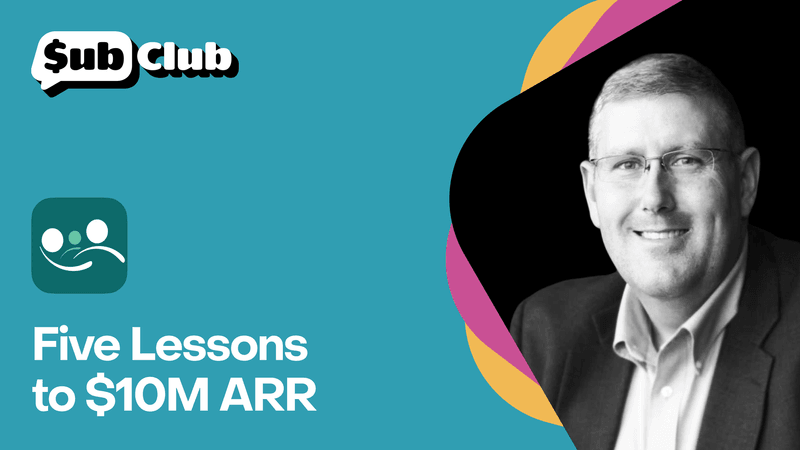Five lessons on the journey to $10M ARR
Discover five lessons from Talking Parents' journey to $10M ARR — from surveying early and often, to providing premium support.

Professional services consulting is no walk in the park. So when Vince Mayfield and his business partner Louis J. Erickson Jr. put their heads together to craft an idea that would make them money in their sleep, their jump from agency to product company was pretty natural.
But they knew going from hired gun to product owner isn’t necessarily an easy leap. Many agencies try, but the skill set is different enough that a lack of focus from the outset means the prospect of failure is never far off.
While co-parenting communication app Talking Parents is a niche business, the lessons its founders learned along the way were nothing less than a blueprint for sustainable, successful app growth.
Here are five lessons CEO of Talking Parents, Vince, learnt on his way to $10 million annual recurring revenue (ARR) — as shared during his episode on the Sub Club podcast.
1. Start surveying early and don’t stop
Product-market fit is elusive in the early stages of app development. To identify the minimum viable product (MVP), understanding customer wants and needs is crucial — and surveys are the perfect tool to achieve this understanding.
“We started asking customers… What do you want? What would you pay for? What features or functions do you like? How can this be better for you? It was pretty rudimentary,” Vince says. Yet even though the questions were basic, the data that came back helped the team figure out and refine what they needed for further iterations.
But you shouldn’t stop surveying once you’ve started growing. Any time you want to add extra value, continuous customer conversations provide key insights for new feature development.
Surveying served the team well in dealing with legacy issues when they began charging for the app. “How do you manage customer expectations?” Vince says. “How do you deliver the value to them so that they feel like they’re getting something unique, willing to continue to pay for, and stick with you?”
Start a habit of surveying early — and stick to it. This practice will pay dividends in the future. If you��’re serving users and coming up with good ideas, you’re building towards and meeting their needs.
2. Bundle extra value when increasing prices
Price increases are a tough sell. But coupling them with the introduction of new, desired features — informed by consistent surveying — can soften the blow considerably. When you have deep product-market fit and new features built and ready to ship, few people will complain when you raise the price.
“At the beginning, we didn’t have a lot of instrumentation,” Vince says. He and Louis assessed what would happen to their customer base if they doubled the price. “We planned that we would lose at least half. And what we were pleasantly surprised [about with the rollout] is that [while] we got a few complaints, people understood that … we added additional value.”
That wasn’t just true of their first price increase — it’s happened every time since.
“Every time we’ve raised prices or busted up the tiers, we’ve made sure that we’ve bundled that with value”
Vince Mayfield, Talking Parents
They establish what that value should be by continuing to ask customers directly.
By listening and responding to customer demands in this way, you don’t just add value but you also demonstrate your attentiveness to customer needs: a key factor of continued app growth and success. At the same time, any app developer not looking at how they can increase prices — and add more value — is doing themselves and their business a disservice.
3. Choose tools with a long-range view
When deciding on your tools, don’t just look at the price tag. Early-stage apps naturally gravitate towards cheaper, easier integrations, but neglecting to consider how these tools will scale in terms of infrastructure and unit economics might mean painful reengineering down the line.
“We’ve made some mistakes,” Vince admits. “From the software engineering perspective and [in terms of] costs, there’s a couple of instances where that burned us.” Startups especially are prone to going for the cheapest option — which may even be a startup itself. But cheaper isn’t always better.
At the same time, be wary of attempting to build it yourself. “RevenueCat was the first tooling that we integrated to basically help us manage our subscriptions,” Vince says. “We tried to build that ourselves, and it was a huge mistake. It was a debacle. We were running around chasing our tails. Every time Apple or Google would change something, it was just a nightmare.”
Time spent building tools to run your business is time you should be spending on product improvements and customer satisfaction.
4. Plan for scalability from the start
In the rush to market, some founders overlook scaling challenges. Adhere to solid software engineering principles and keep an eye on tooling from the get-go to limit potential pain points farther ahead.
When you grow and want to scale, you have to ensure that the tools you use can scale with you — otherwise, you’re creating a scaling problem. Despite early setbacks, when Vince and his partner shopped around for what might scale better with their app, they ended up cutting their costs in half.
If you choose cheaper tools that integrate well in the startup phase, ensure that they’re easily switchable without causing big headaches when you’re forced to adopt new ones in order to scale.
“The key thing for those that can’t necessarily [afford] best in class in the beginning … is just to follow good software engineering techniques in a way that [means] you can pull stuff out as you go,” Vince says.
During the growth phase, most apps iterate year to year. By engineering well early, you can make necessary changes and switches quicker with better design.
5. For a premium price, provide premium support
Every interaction leaves a lasting impression on customers. When you respond to every single review on app stores, you make reviewers feel heard — and provide valuable insights to prospective downloaders browsing the App Store and Google Play listings.
“Every experience that somebody has with your brand sets a mental image of who you are,” Vince explains. “You’re not writing it to answer just that person. You’re writing it for everybody that comes behind it.” Thoughtful, reasonable, and empathetic answers boost retention and audience opinions of your app.

But this doesn’t just apply to reviews. Email and phone support amplifies the same effects by increasing the number of available channels open to customers. “They’re the ones that are paying us for the service,” Vince says. “If they feel like we’re listening to them, they’re going to continue to stay subscribed, and we’re going to have great retention rates.”
Universal lessons for scalability
The nuances of Talking Parents’ business don’t apply to every app. But all developers hungry for growth and scalability can learn from Vincent’s efforts to increase the value consumers get from using the app.
At one time, apps that charge more than $100 a year might have looked expensive. But if they deliver value to match that cost, those who use (and appreciate) the app will see that value.
Likewise, Talking Parents’ premium-tier $25-a-month price point can look high until you see what value they’re bringing to the table. When you can justify your offering as valuable, growth and success won’t be far behind.
You might also like
- Blog post
Scaling UA without wrecking your conversion rate: A Meta campaign playbook
A structured testing system helped one app lower cost-per-trial while targeting its most profitable users
- Blog post
Gamification in apps: A complete guide to using motivation to drive real value
Why streaks fall short and 11 apps getting gamification right
- Blog post
Apple’s June 2025 EU update: one entitlement, three fees, and CTF’s 2026 sunset
What apps in the EU should do after Apple’s DMA tweak.

